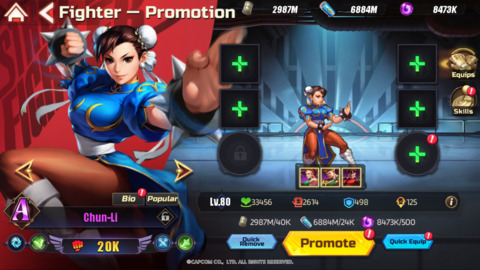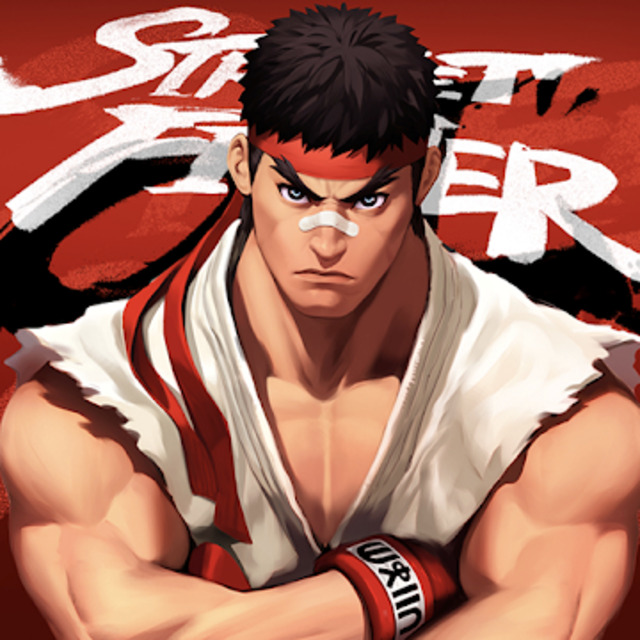Overview
Street Fighter: Duel is a free-to-play mobile game with gachapon systems, using the Capcom license to portray various characters and locations. The core of gameplay consists of assembling a team of four fighters, which can be supplemented in various ways. Three of those characters are active in battle, while the fourth is sidelined and only tags in for a Super move or when one of the main roster falls. Super moves are activated by performing regular attacks that fill a bar. An initial Super can be combo'd by up to three more special attacks, though the same fighter cannot follow up on themselves. It is, however, possible for characters to perform multiple Supers in the same chain, granted that they are the fighter who starts the chain, as long as they have that skill unlocked and it is not a consecutive combo.
In addition to the four fighters, up to two more can be attached to the roster as assists. These appended slots do not appear in combat but do boost the stats of the active line-up. Up to three more Ex Moves can be slotted into the party, which are powerful modifiers that can be activated during combat, but at the cost of a heavy cooldown cycle. Ex Moves can be acquired through very rare currency or by achieving a set of demanding missions. Most players will only see a few of these special attacks, which either destabilize enemies or heal the active party.
Each fighter on a roster has a specific class, such as Tank and so on, along with an elemental trait. There are six of these elements: Wind, Thunder, Flame, Infernal, Master, and Legendary.
The three regular elements can synergize with their respective trait, boosting stats on the roster, while the three specials work slightly differently. Legendary does not synergize at all. At best, the roster can have a synergy score of four members from one element, enhanced with two members of a different element that's equal to their respective trait. For example, four wind units and two fire units have a perfect synergy. As there are only four active slots, these fighters do not need to appear in the active roster, but can be placed as an assist as well.
As with any gacha games, characters range from a rating of C up to SSS, with an additional '+' subset. For instance, to get a unit from C to B, they would first need to be brought up to C+, before restarting the process from C+ to B.
Along with traditional leveling systems, which require a set of currencies, a fighter also comes with four equipment slots. As with most other systems in the game, the equipment can additionally be leveled by feeding leftover gear into them. Equipment levels up three times, raising more stats for that unit. Some gear has a certain element attached to it.
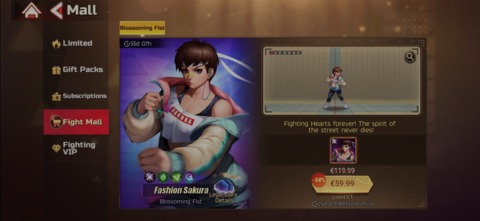
Currency is acquired mostly by clearing objectives, as well as the act of idling. Resources, as well as gear, will actor accrue the longer a player waits to collect them, up to a certain amount of time. The premium currency of gems can only be acquired through various objectives, as well as obtained by purchasing them through microtransactions, naturally.
Other microtransactions can include a Battle Pass system, login bonuses or the purchase of fighters with a different cosmetic look than their main counterpart. Some transactions can go upward to three figures.
Modes
Gameplay for Street Fighter: Duel happens in various branches that can be accessed from the main screen.
Challenge:
The Challenge section follows a linear story progression. Clearing stages can unlock a variety of requirements, such as working towards Ex Moves or boosting the amount of resources that idling yields. A Challenge zone is usually capped off with a boss fight, which comes with a small dialogue interaction that occurs on the bottom right of the screen. After completing a zone, the players then travel across a world map, similar to the screen in Street Fighter II, though without the iconic sound bites.
Upon completing certain stages, a Task may appear that either asks the player to defeat a specific roster or throws in a timed questionnaire.
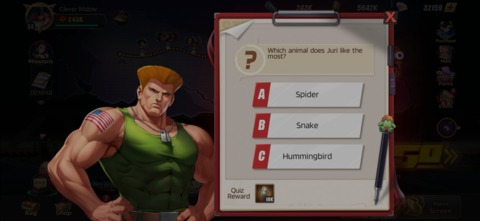
Explore:
In the Explore section, there are various gameplay variants. One of those sections is Bounties, where units can be sent to do missions for a number of hours, yielding currency in return, much like the idle systems in games like Assassin's Creed. One of these missions require a unit Recruit that comes from befriending other Street Fighter: Duel players.
Shadaloo is a location in the Explore tab as well. Here, gameplay follows the structure of Slay the Spire, where progression happens by choosing different branches along a path. Most of these branches contain fights against an increasingly more difficult opponent. The active roster has persistent health in this mode, meaning that the damage they take is carried over to the next fight. In branches that don't contain combat, players can recruit fighters from others, heal their roster, revive a fallen unit or visit a limited shop when premium currency. A limited crystal currency can also revive and heal every fighter, if no branch is available. Each Shadaloo path is ended by a boss fight, before the roster teleports to a new section.
Supreme Fist is another challenge in the Explore section. This works as a near-endless version of Mortal Kombat ladders, where the goal is to defeat an increasingly more powerful team. A prize is earned after each tenth fight is cleared.
Global Operation is yet another series of fights in the Explore tab, performed on a separate map with an amount of small puzzles that players need to traverse. These challenges can be as simple as turning a lever or require sliding on ice in the correct pattern.
Arena:
The Arena tab is mostly used for the player versus player (PvP) interaction in Street Fighter: Duel. Fighting against other players require a specific ticket. Winning a battle yields a number of points, depending on how many fighters survive at the end. The amount of points determine the player's place on a leaderboard, which resets every so often for a new season.
Players can set up a roster as a defense team. It is possible to view battle records from other players who fought the team. Additionally, it is possible to see what rosters other players on the leaderboard have set up.
Aside from the main PvP section, there is also a Battle Royale and Showdown branch for advanced players that make it past a pretty far place in the Challenge section of the game.
Training
The Training tab has no combat, as it is the place where players can grow their fighters in various ways.
Ex Moves:
This section shows list of Ex Moves, as well as the conditions to unlock them. Acquired Ex Moves can further get enhanced here as well, either with a specific currency or with duplicate shards for that specific move.
Awaken:
This is where players feed their units to other units, to increase their rating from C, all the way to SSS. It is possible to awaken automatically at random, but also dismiss certain units, as the inventory for units is limited. Awakening certain higher grade fighters will prompt a warning before completing that action, to prevent accidently feeding a unit. Fed units are lost forever.
Dojo:
This section is a small base building feature, which increases resource yields. Along with building a few buildings and collecting chests at certain time intervals, players can also visit their friends' Dojo and get chests from there as well.
Limit Break:
This section allows players to artificially boost the level of a unit. Units will be brought up to the lowest level of the four highest fighters from a player's inventory. For example, if the four highest characters include three at level 80 but one at level 60, boosted units will only grow to level 60. Boosted units take up permanent residence in their slot. Boosted units can not be promoted to a higher level while residing in a slot, as they are not their original level. It is possible to remove a boost from a unit, but the slot they were in will receive a lengthy, hours-long cooldown to prevent mixing and matching. It is, however, possible to purchase additional slots.
Auxiliary systems
Main screen:
The main screen features a list of additional gameplay features. For instance, players can join a Guild that has its own set of challenges, as well as a shop with specific guild currency.
Draw is the main element in the main screen. This is where the gacha system is; where players put in an amount of rare currency to get new fighters. At launch, there are three different slot reels.
Friends can be added, which can contribute to the recruiting mechanism in Bounties or the yields in the Dojo section. Additionally, friends can give each other a specific currency used to draw more fighters.
Missions hold both daily and weekly objectives, which are mostly centered around activity, as well as a list of specific challenges. These objectives range from clearing a certain part of the game or acquiring more units of a certain level.
In the Bag section, players will find their inventory, which holds gear, resource boosts and other limited drops. For instance, players can acrue an item that will automatically yield a new fighters of a certain rating.
Shop is where players can exchange premium currency for items and other various goods. There are also shops for different types of currency, such as a Guild shop or items that can be bought with the regular cash resource.
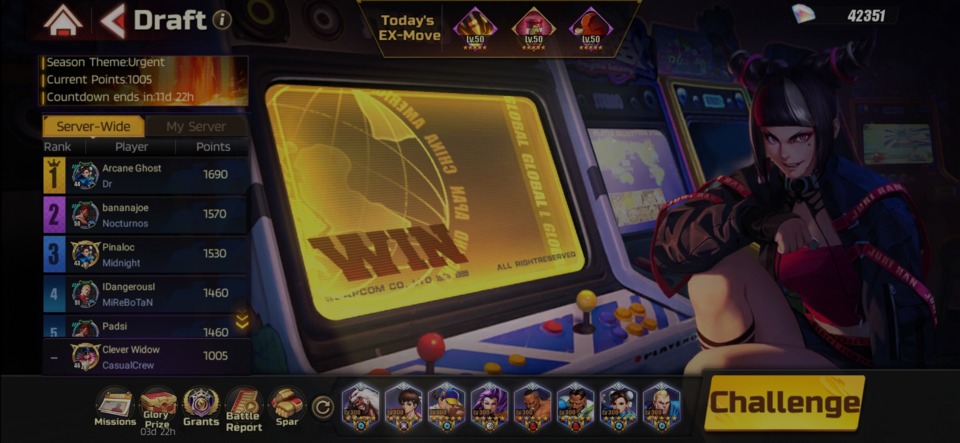
Draft:
As the name suggests, this game mode uses a drafting system. Before playing, users have to draw eight fighters from a stack of choices. For each of the eight slots, the player is given three choices that can be inspected for statistics and moves before confirming and repeating the cycle. Those eight fighters essentially work as the deck for the player, which shows up at the bottom of the screen. Every fighter included has maxed out stats, at level 300, with a SSS rank.
Hitting the Challenge button on the bottom right of the screen starts real-time matchmaking with other players, eventually leading into a pick round, akin to games like League of Legends. Players take turns in assembling fighters in their usually four active slots, though no assist units can be appended in this mode; it's just the main roster of four. One person chooses, then the opponent goes and so on, to ensure that players can choose counters, if they are available. A game starts after final adjustments.
Ex Moves are part of this round, but they are not chosen from a player's possessions. Instead, a random selection of three maxed out moves, at level 50 and five stars, are available to both squads. A round ends after one player no longer has any fighters left. Points are distributed similarly to the Arena mode, where surviving players are counted.
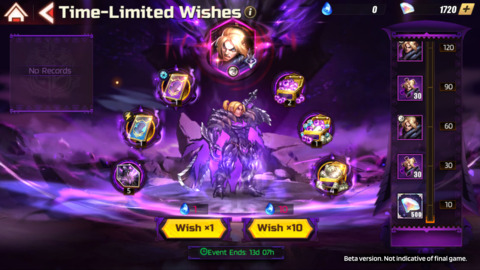
Collaborations:
Most of the Street Fighter: Duel line-up is compromised from fighters coming from the Street Fighter franchise. There are, however, also special events that can yield gear and other references from different licenses. For instance, Capcom's other popular series, Monster Hunter, has appeared in the game before.
Teenage Mutant Ninja Turtles:
On April 17, 2024, the global release of Street Fighter Duel launched its first collaboration with a property outside of Capcom products. In a two-part event, Nickelodeon brought the four main characters from the Teenage Mutant Ninja Turtles to the mobile game, along with a series of special sub-games.
In the “Ninja Operation” section of the main menu, there is a hub modeled after the sewer home of the Turtles. This place is populated with the usual promotional sections, such as a boss fight mini-game or the section to increase stats for this particular event only. The familiar sections, which are the same for every special event, are as follows:
- Cyborg Attack: A linear gauntlet of encounters that leads to a boss fight.
- Shadaloo Duel: A boss fight against a powerful version of one of the characters in Street Fighter Duel, split up in four different teams.
- Limited-Time Wishes: The slot reels for trying to acquire Turtles as a playable character
- Pizzeria: A shop to spend event-specific currency, Pizza, to purchase helpful items for the game in general
- Turtle's Gift: An advent calendar-like space with redeemable blind box items.
- Workbench: A system to increase potency for the event, as well as unlock a new Ex-move that's based on the Turtles.
Another part of the hub is populated by a bespoke adventure, called “Crossover.” In this puzzle section, players navigate sewers with lots of teleports, to search for clues and treasure that can yield event tickets. These tickets can then be used to attempt receiving a ninja turtle. Leonardo and Michelangelo are part of the first event, while Raphael and Donatello are in the second part. Using enough tickets will guarantee a drop for a specific ninja turtle. There is also a light story element here that sees M. Bison team up with Shredder and the Foot Clan.
Pre-registration:
Before the release of Street Fighter: Duel to Western territories, people were able to pre-register for a set of bonuses, such as various currencies, more units and an exclusive border for their player icon. Upon the launch of February 28, 2023, over 5 million people had signed up for the game

 iPhone
iPhone iPad
iPad Android
Android




